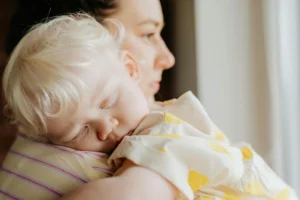When talking to new clients, we ask questions about their current nap and bedtime experiences. The insight we gain from these conversations helps us know what practices need to be addressed and implemented. There is one situation that seems to be very common, the drowsy but not asleep child. Parents often think they are putting their child to sleep when they are awake but really, the child is already in the beginning stages of sleep. They may seem “drowsy but awake,” not “awake awake.” This means their child isn’t truly learning how to fall asleep on their own. So let’s answer the question, Is Your Baby Truly Falling Asleep On Their Own?
The Stages Of Sleep
For this concept to make sense, it might help to understand the stages of sleep. We cycle through these stages multiple times each night.
- Stage 1 – Drowsiness. Heavy eyes, slow movements, almost asleep.
- Stage 2 – You are fully asleep but it is a light sleep. You are not fully aware of events occurring around you. Your body temperature lowers, breathing and heart rate begin to regulate and eye movement slows down and stops.
- Stage 3 – Your brain waves begin to slow down and there is minimal activity. This is a deeper sleep that it is hard to be woken up from. Your breathing continues to slow and your muscles relax. When you wake up in this stage, you most likely feel disoriented.
- Stage 4 – You continue to get into a deeper sleep during this stage with your breathing and heart rate getting to their lowest and your brain waves slow down even more. This stage is very difficult to awake from.
- Stage 5 – REM – You have reached the final stage of sleep when you enter REM. You begin to dream when you are in REM and your body paralyzes so that you act out your dreams. Your eyes move quickly under your eyelids, heart rate and blood pressure increases, and your breathing quickens as you take shallow breaths.
- When all of these stages are complete. You wake up, and start again. This happens 4-6x per night
Awake Awake VS Drowsy But Awake
There is a common misunderstanding when it comes to putting babies to sleep. Parents often think that they are putting their little one to bed when they are “drowsy but awake.” In reality the baby has already entered the first stage or two of sleep. A key part to sleep training is learning how to put your baby to bed “awake awake.” This is when your child learns to self soothe rather than depend on someone else to sway, sing, pat, etc. them to sleep. You can gauge how awake your child is by how alert they are to their surroundings. How now you can answer the question, is your baby truly falling asleep on their own?
How Can Rocky Mountain Sleeping Baby Help?
We don’t think that you shouldn’t have those bonding moments with your little ones. Those tender moments should be cherished. What we aim to do is help parents gain a little more of their time back by not having to spend endless hours coddling their child to sleep. If you have the time and desire to do so, then we support you in that but a lot of families simply do not. We help parents learn how to read their child’s body language and cues along with establishing routines. This empowers parents to be able to put their child to bed in the most efficient way.





